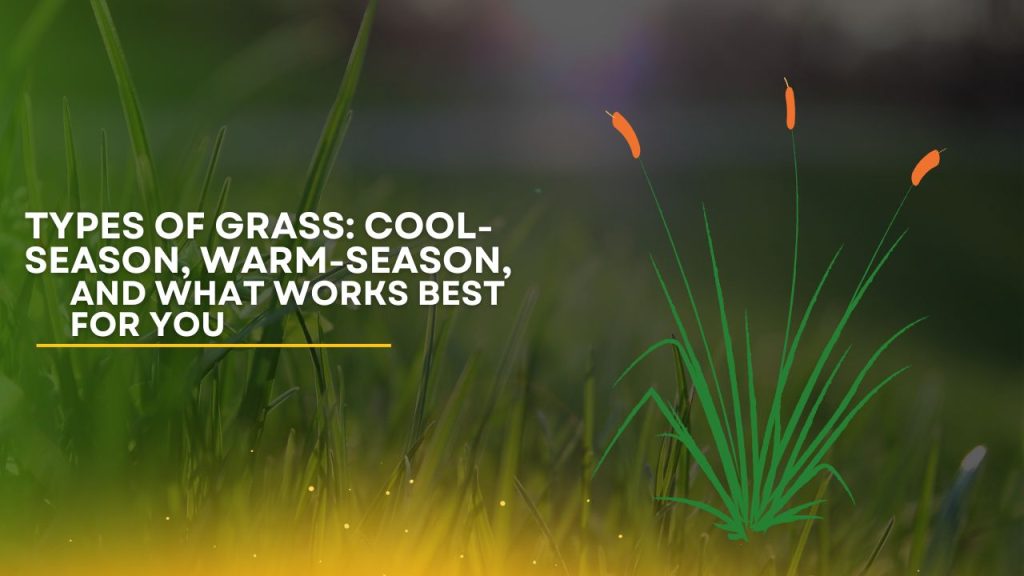Not all grass is the same. Some love the cold. Some crave heat. Others hang in the middle, struggling a bit but still surviving.
Choosing the right type matters. Whether you’re fixing up your yard, planting a sports field, or managing a park, grass isn’t one-size-fits-all. What works in Michigan probably won’t thrive in Texas.
Let’s walk through the main types of grass and help you figure out what fits your climate and goals.
Classification of Grass Types
Most grass falls into three main groups:
- Cool-season grasses
- Warm-season grasses
- Transitional or mixed-zone grasses
Each group grows best in certain temperature ranges. Some bounce back better in fall. Others need hot weather to shine.
But beyond climate, think about your needs too. Do you want low maintenance? Thick green blades? Drought resistance?
Let’s break down each type.
Discover More : Mushrooms In Lawn: Causes, Risks, and How to Manage Them
Cool-Season Grasses
Cool-season grasses do best in areas with cold winters and mild summers. They grow fast in spring and fall. In summer, they may slow down or turn brown.
Common Types:
1. Kentucky Bluegrass
Loved for its rich color and thick coverage. It spreads well and handles foot traffic. But it needs more water than some others.
2. Perennial Ryegrass
Germinates fast—often in just 5 to 10 days. Great for quick patches or overseeding. It doesn’t spread on its own but grows upright and clean.
3. Tall Fescue
Tough and drought-tolerant. It has deep roots, which helps during dry spells. Newer “turf-type” varieties look nicer than older ones.
4. Fine Fescue
Best for shady areas. Doesn’t love heat but doesn’t mind poor soil. You’ll often find it mixed with other grass seeds.
Climate Zones:
Cool-season grasses thrive in the northern U.S., parts of Canada, and elevated regions. Think: Chicago, Boston, or Portland.
Warm-Season Grasses
Warm-season grasses love the heat. They go dormant and brown during cold months, but in summer? They’re unbeatable.
Common Types:
1. Bermuda Grass
Grows fast, spreads fast, and handles lots of use. Ideal for sports fields and sunny lawns. Not great in the shade.
2. Zoysia Grass
Soft to the touch but strong. Tolerates some shade and foot traffic. It’s slow to spread but creates a thick, carpet-like lawn.
3. St. Augustine Grass
Big, wide blades. Grows well in warm, humid areas—especially near the coast. Loves sun but tolerates shade too.
4. Centipede Grass
Low maintenance. Doesn’t grow too tall, so it needs less mowing. Better for acidic soil. Doesn’t like high traffic.
Climate Zones:
You’ll find these grasses thriving in the South—Florida, Texas, Georgia, and Southern California. They like soil temperatures over 70°F.
Transitional Zone Grasses
This is the trickiest region. It stretches across the central U.S.—places like Missouri, North Carolina, and Kansas. It’s too hot for some cool-season types. Too cold for most warm-season kinds.
What’s the fix? Flexibility.
Options:
- Tall Fescue: Does well here. Deep roots help during heat. Handles some cold too.
- Zoysia: Withstands the cold better than Bermuda.
- Blends or Mixes: Some seed mixes combine types to handle changing seasons.
What to Expect:
Lawns in this zone may need overseeding, more water, and varied care through the year. It’s not impossible—it just takes planning.

Choosing the Right Grass for Your Climate and Needs
So how do you pick?
Start with Your Climate:
- Northern U.S./Canada: Go with cool-season grass.
- Southern U.S.: Warm-season is the better fit.
- Middle Zones: Pick flexible species or blends.
Think About Your Yard:
- Shade or full sun? Fine fescue handles shade. Bermuda wants sun.
- Heavy use? Choose ryegrass or Bermuda.
- Low maintenance? Centipede or tall fescue need less mowing and fertilizing.
Check Soil and Water:
- Dry region? Pick drought-resistant types like tall fescue or Zoysia.
- Poor soil? Some grasses tolerate sandy or clay-heavy dirt better.
And don’t forget your goals. If you want a green lawn year-round, pick a mix that includes something for every season. Want a fast fix? Ryegrass can green things up quick, but won’t last through a hot summer.
Discover More : When to Fertilize Lawn: A Simple Guide for Healthy Grass
Conclusion
Grass might look simple, but picking the right type makes a big difference. The wrong choice leads to more work and weaker results. Start with your climate. Match the grass to your soil, sun, and use. And if you’re in the middle zone, be ready to mix and adapt. A good lawn doesn’t come from guesswork. It starts with the right seed in the right place.

